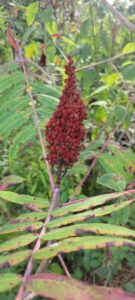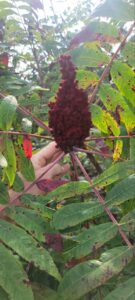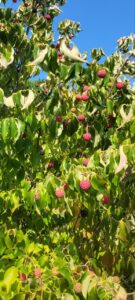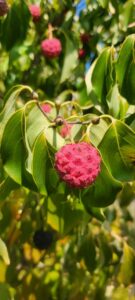This post accompanies my foraging segment for The Survival Podcast, which can be located here: https://www.thesurvivalpodcast.com/
The Expert Council episodes always air on Thursday.
Hey TSP community, it’s Kerry Brown from Strong Roots Resources and today I’m bringing you two species worth foraging that are currently available in much of the United States.
First is the edible sumac – there’s several types available – the one pictured here is winged sumac.

These deep red berries can be used to make sumac-ade, a tangy, refreshing drink that’s best brewed like sun tea. When you gather these berries, just clip off the entire cluster and steep for a few hours in the sun or at room temperature. Play around with the amount of berries per gallon of water – I usually go with about 4 clusters per gallon of water for a robust flavor. There’s no need to boil the water – that’ll result in tannins being transferred and a bitter taste. Apply just a little of your sweetener of choice and enjoy. Over time and with rainfall, the berries lose their flavor, though it’s not uncommon to find berries still worth using in late fall and early winter. If they’re still a bit oily to the touch, they are usually still flavorful.

I have a small stand of these on the downhill portion of my food forest that I’ve designed around since they’re a good fit as a shrubby hedge.
To note – all red sumac berries are edible. Poisonous sumac berries are always white – and these shrubs that result in a poison ivy type dermatitis are generally found in wetter locations. Edible sumacs – to my experience – are found in dry locations. So be certain of what you’re interacting with.
The second plant I want to cover is the Japanese, aka Kousa dogwood. This cultivar is pretty common in conventionally planted landscapes, with the bonus of providing a very tasty fruit. The entire fruit is edible, though sometimes the outer portion is a bit bitter. The inside often has no seeds or only small ones and is a soft, custard like flavor. I was recently working on a customer’s property and her Kousa were loaded with fruit. It reminded me that I definitely need to incorporate a couple here at our own place.

There’s a good chance you have neighbors with Kousa that have no idea how tasty their fruit is. I’ve seen them planted around shopping centers too. They can be propagated from softwood cuttings early in the season – I’ve added a link on how that’s achieved as buying these mature trees from garden centers can be pretty expensive.

Dogwood Tree Propagation – How To Grow Dogwood Cuttings | Gardening Know How
Cornus kousa Japanese Dogwood, Kousa dogwood, Chinese Dogwood, PFAF Plant Database
If you’d like to learn more about the wild medicinal, edible and otherwise useful species on your land, I offer in person property walks, foraging classes, consulting and education as well as identification, GPS tagging and documentation of those species on your property. My travel radius is within about 4 hours of Knoxville, TN so feel free to reach out to me via strongrootsresources@gmail.com to discuss the options available.
Y’all have a good week and I’ll talk to you next time.
